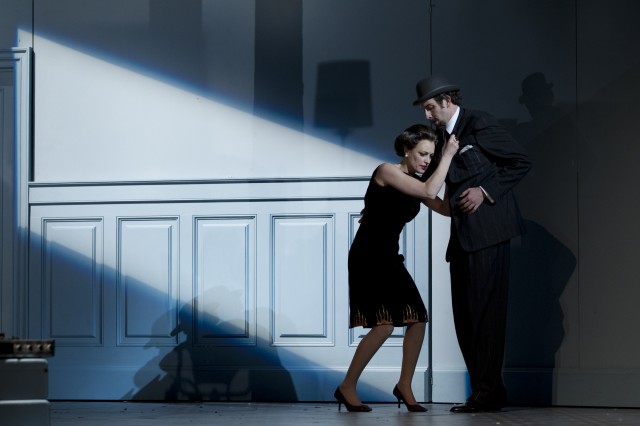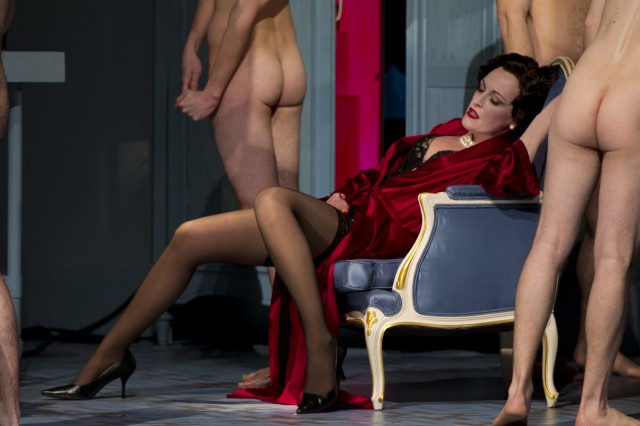In 1963 a great scandal erupted in Britain. During the divorce case against Margaret Campbell, the Duchess of Argyll, the public learned that she had extramarital affairs with some eighty-eight men. Polaroids were presented as proof; she appeared nude, and in some cases was even pictured giving blow jobs.
The salaciousness of this story is reproduced in tantalizing detail thanks to a new production by the New York City Opera of Thomas Adès’s “Powder Her Face”. (The show opened last Friday at the Brooklyn Academy of Music and runs through February 23.) It’s great fun to watch, but offers little by way of substance. Even knowing that’s by design, this particular rendition makes it especially difficult to care about the production itself thanks to array of issues. These range from bewildering set design to accomplished but soulless performance.
The first act opens in 1990 in the hotel where the Duchess lives; an electrician and the maid are discovered in her suite, making fun of her. From there, flashbacks tell us of the Duchess’s extravagances. The play has the feel of Joris-Karl Huysmans’s “A rebours”, a story about a millionaire whose wealth inflicts such boredom he retreats from society to dedicate his life to contemplation. Real life, as told here though, is more tedious than filled with contemplation: the play depicts the duchess as a demanding insufferable woman unconcerned with her own superficiality.
Most of the media chatter about the production has reliably focused on the blowjob scene, which comes about halfway through the first act. 25 naked men literally come out of the woodwork for this vignette—out of wardrobes, bathtubs, and any available stage wing—all in an effort satisfy Campbell’s insatiable appetite. The Duchess, played by Allison Cook, heroically sings throughout the entire job.
It’s a great scene, in no small part, because as an audience member, it’s nearly impossible not to oogle over all those dicks in various states of fluffery. You’re implicated in the scale of the media scandal reproduced here, and you feel that immediately.
This plays out at other points in the opera as well, albeit less successfully. Undoubtedly, the most obvious example of this is real-time camera footage of the characters, which is projected onto the set walls. Here too, we’re meant to be tantalized and implicated as media-obsessed onlookers, but the effect falls flat. Today, we’re so used to moving billboards and NC-17 social media sites that a few larger-than-life projections of the cast dry humping each other and snorting coke don’t do much more than reiterate what we already see.
Director Jay Scheib, stumbles a little bit in this regard, as the sets are often unsuccessful. Trees, for example, provide the background for the second act’s courtroom, and their symbolism is obtuse. In other scenes at the hotel, the sets are simply banal.
As a result, the success of the opera often rested solely on the performances of the cast: Allison Cook, a dark mezzo-soprano as the villainous Duchess; Nili Riemer, a nimble coloratura soprano as the gregarious Maid; and Matt Boehler, a chameleonic bass as the dim-witted Duke. Each are undoubtedly skilled, but the transformation of voice into character, is rarely achieved, so the music is never as moving as it should be.
Unfortunately, this is fairly consistent with the opera as a whole. Adès doesn’t leave much room for empathy (and arguably the characters don’t deserve any), so while it was probably never going to be a piece easy to love, the set design and performances don’t do much to make up for that. For all the salaciousness this opera has to offer, the production leaves little for audiences to remember.




{ 1 comment }
thanks for this review!
Comments on this entry are closed.